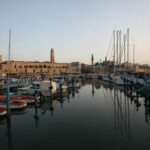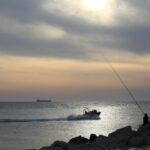Visit the lively port bustling with food and entertainment.
Akko’s first port was presumably located along the lower section of the Na’aman River. The port was first mentioned in Cambyse’s ‘ journey to conquer Egypt in 527-525 BC during the course of which Akko boasted hundreds of ships carrying soldiers, horses and supplies
The Port of Akko
Akko’s first port was presumably located along the lower section of the Na’aman River. The port was first mentioned in Cambyse’s journey to conquer Egypt in 527-525 BC during the course of which Akko boasted hundreds of ships carrying soldiers, horses and supplies. The fact that Akko served as a base for a fleet of such magnitude indicates that the breakwater had already been built.
The port during the early Moslem Period
Reference was again made to the Port of Akko with the establishment of the Umayyad Dynasty during the days of Muawiya. Sultan Muawiya decided to fortify the settlements along the coastline as part of a maritime policy, which culminated in the conquest of Cyprus that became part of the Moslem Empire. It was within this context that a large shipyard was built at the Port of Akko, however it had a short lifespan. Egyptian ruler Achmad Ibn-Tulun (868-884) annexed the Land of Israel and a substantial part of Syria and, in the midst of organizing his princedom, he decided to renovate the Port of Akko and its fortifications, similarly to what had been done in Tyre.
The port during the Crusader Period
During Crusader rule, the port of Akko played a more central role. Its naval ties to the West were founded on this port, which was essential to its very existence. Even though most of the maritime activity was limited to the May to October period, considerable space was required to store goods and equipment for the pilgrims’ accommodation as well as for the repair and mooring of ships.
The port during the Ottoman Period
Following the Ottoman conquest, use of the port declined and it only served as a marina for fishing boats. Paintings of 18th century passengers depict the southern breakwater and the Crusader wall, the remains of which still remain impressive.
The fortified building on the Tower of Flies was very well preserved and a mosque was built on top of it. In the late 17th century, Daher el-Omar tried to renovate and fortify the city. Toward the end of his life, he had presumably managed to rehabilitate the port to the extent that sailboats could cast their anchor there and load cargo within the scope of his policy to develop maritime commerce.
During the first third of the 19th century, the port was kept in good working order and it often served the Egyptian fleet of Muhammad Ali and Ibrahim Pasha. The port was destroyed during the shelling of Akko by the British and Austrian navies in 1840, when the breakwater wall and the Tower of Flies were damaged.
Port of pilgrimage to the Land of Israel
From time immemorial, the Holy Land has attracted pilgrims – especially Jews and Christians. Many of them arrived to Israel through the Port of Akko. Akko’s status grew, primarily after its conquest by the Crusaders in 1104, when the port became the main gate to the Land of Israel.
















